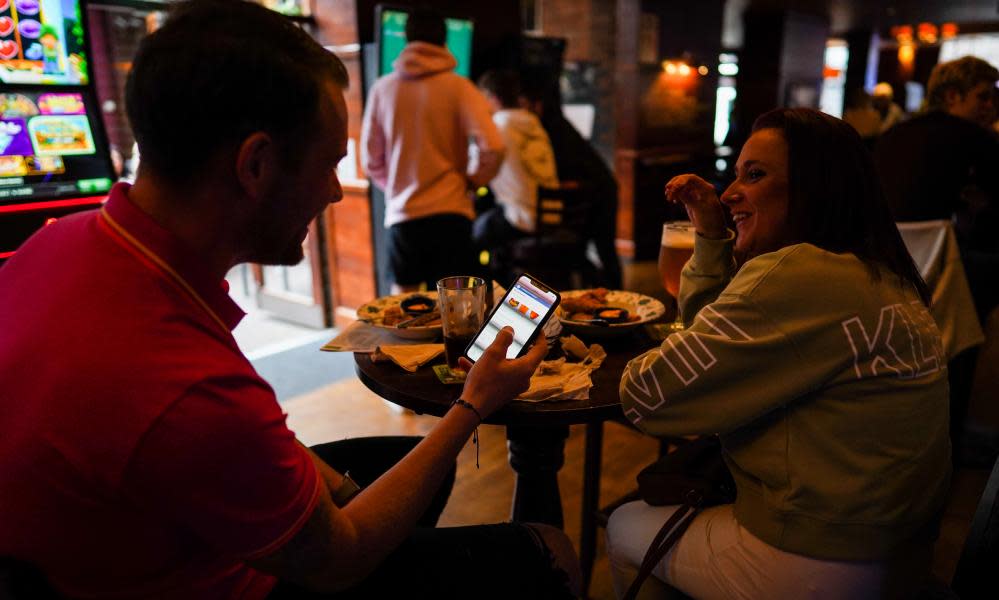Take-up of NHS contact-tracing app could be only 10%

Take-up of the NHS Covid contact-tracing app being launched in England and Wales on Thursday – and once touted as key to controlling the pandemic – could be as low as 10% in some places, government sources believe.
International examples show take-up rates of similar apps at between 10% and 30%, a far cry from the NHS app target in April of 80% of smartphone users. Oxford University’s Big Data unit, which advised the government on its development, said that would be the equivalent of 56% of the population.
The app, which uses Google and Apple technology, will alert the user if they have been within 2 metres for more than 15 minutes of somebody who has tested positive, and who also has the app.
Other functions allow the user to check in at a venue that displays a QR bar code, rather than having to give staff their details. The user can book a test and will be given advice on self-isolation if necessary, including a daily countdown so they know when they can leave home again.
Pilot studies on the Isle of Wight, in the London borough of Newham and among NHS volunteers have shown that downloads of the app are similar to in other countries. The highest rate, of around the 30%, was on the Isle of Wight, where an earlier trial meant people were already used to the idea of a contact-tracing app. In Newham the take-up was nearer 10%.
Officials at the test and trace programme, however, believe there will be benefits even if few people adopt it. A recent study by the same data team at Oxford University, looking at the experience of Washington state in the US, found that if 15% used an app that notified them of exposure to an infected person, infections were reduced by 8% and deaths by 6%.
There is now recognition that the only way out of the coronavirus crisis, short of a vaccine, is through behaviour change. It is hoped the app will prompt people to talk about and remember the basics – to wash their hands, keep their distance and wear face masks where required – and get tested and self-isolate if they have been near a person with coronavirus.
Matt Hancock, the health secretary, has now toned down his rhetoric. “We are at a tipping point in our efforts to control the spread of this virus. With infection rates rising, we must use every tool at our disposal to prevent transmission, including the latest technology,” he said.
Contact tracing is one of the most basic planks of public health responses to a pandemic like the coronavirus. It means literally tracking down anyone that somebody with an infection may have had contact with in the days before they became ill. It was – and always will be – central to the fight against Ebola, for instance. In west Africa in 2014-15, there were large teams of people who would trace relatives and knock on the doors of neighbours and friends to find anyone who might have become infected by touching the sick person.
Most people who get Covid-19 will be infected by their friends, neighbours, family or work colleagues, so they will be first on the list. It is not likely anyone will get infected by someone they do not know, passing on the street.
It is still assumed there has to be reasonable exposure – originally experts said people would need to be together for 15 minutes, less than 2 metres apart. So a contact tracer will want to know who the person testing positive met and talked to over the two or three days before they developed symptoms and went into isolation.
South Korea has large teams of contact tracers and notably chased down all the contacts of a religious group, many of whose members fell ill. That outbreak was efficiently stamped out by contact tracing and quarantine.
Singapore and Hong Kong have also espoused testing and contact tracing and so has Germany. All those countries have had relatively low death rates so far. The World Health Organization says it should be the “backbone of the response” in every country.
Sarah Boseley Health editor
“We have worked extensively with tech companies, international partners, and privacy and medical experts – and learned from the trials – to develop an app that is secure, simple to use and will help keep our country safe. Today’s launch marks an important step forward in our fight against this invisible killer and I urge everyone who can to download and use the app to protect themselves and their loved ones.”
Dido Harding, chair of NHS Test and Trace, also emphasised that the app was no substitute for human interaction. It would “work alongside our traditional contact tracing service and will help us to reach more people quickly in their communities to prevent further spread of the virus”, she said. “This is a welcome step in protecting those around us.”
Prof Andrew Goddard, president of the Royal College of Physicians, said the app was a step in the right direction but would need ongoing evaluation and improvement. He said people would have to be certain their data was anonymous. “As the situation evolves, policymakers are having to be responsive in the way public health guidance is developed, and we do not want people to be worried about using the app for fear of being identified and fined if they break the changing rules,” he said.


